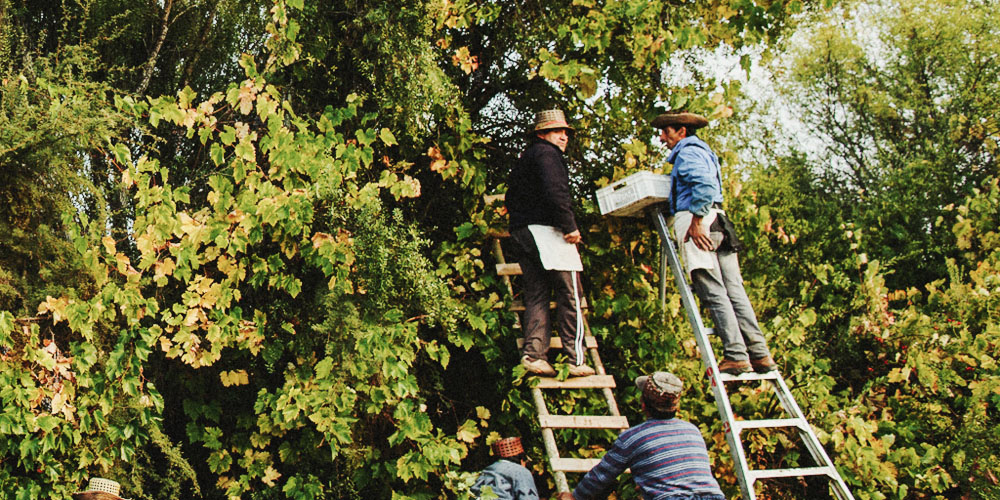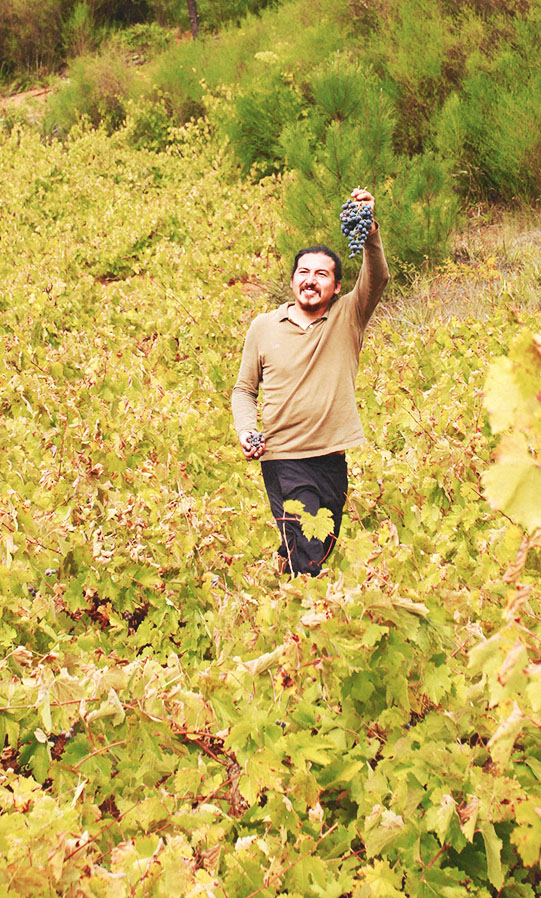
The tale of the País grape is epic: religious conquest, heroic resistance and a long downtrodden period simmering in crushing poverty. For the last decade, a few winemakers in Chile have been writing a new chapter for this historic grape.
I will get the wine stuff out of the way early so we can get to the conquistadores. País, in a bottle, tends to be a light-bodied, quaffable red wine, often used as a substitute for Beaujolais. Some Países have a delightful spicy complexity. Plus, the wines are not expensive. Until recently, the grapes were as cheap as they get in the developed world.
After being unwanted for centuries, País is suddenly cool, even in places where Chilean wine is not.
Derek Mossman, a Canadian expat who runs Chile’s Garage Wine Co., dropped by the well-regarded restaurant Gramercy Tavern during his first visit to Manhattan 10 years ago, when he was selling his dry-farmed single vineyard wines. He asked if they had any Chilean wine on the list, to which they replied: “Nothing. What kind of establishment do you think this is?”
Light-bodied, quaffable red wine. Some have a delightful spicy complexity.
Today, it is a different story; País is now hip. While drinking wine in Santiago, Mossman explained: “Today, País is on by the glass at the Gramercy Tavern. They sure as shit don’t have a reason to put Carmenere on by the glass. But País broke through.”
It certainly took a long time for País to become hip. It has been grown in the Americas since 1540, when Spanish priests took it to Mexico to be drunk at religious ceremonies.
Paradoxically, a wine named ‘country’ by Chileans has no country to call its home. It is now extinct in its homeland, Castilla-La Mancha in Spain, where it was known by the name Listán Prieto. In North America, it was called Mission (and you can still find some in California by that name). It has been grown in the Canary Islands since Spanish ships dropped off some grapevines there on their way to the New World. Until DNA testing revealed the País’s origins, Canary Islands was assumed to be the wine’s original home.
In Chile, the native population, known as the Mapuche people, fought violently against País at first. In 1541, at the end of Spain’s first attempt to colonize Chile, the Mapuches, led by chief Michimalonco, destroyed the new city of Santiago and burned all the crop fields, likely including País vineyards. The Arauco War against the native population went on for more than 300 years. As the Spanish got a foothold in different areas, Spanish priests planted more País. And despite their numbers being reduced by dramatically by European diseases, the Mapuches continue to resist deforestation of their ancestral territory today.
País offered great virtues to farmers: it tolerates heat and drought well and when the vines are young, produces big crops. In the 21st century, when we are witnessing global warming, heat and drought resistance is a good thing. Big crops? Not so much.
País’s other flaw? Berries from young vines are big, irregularly sized and very juicy, which can result in watery and weak wines. This is perfect for sacramental wine but not so much for fine dining. Leading it to be torn out and replanted in most of the world.
As Chile’s main wine grape for centuries, País fell out of fashion fast in the 1800s. Some Chileans got rich from mining and used their money to travel to Europe, where they fell in love with Bordeaux wines. These industrialists brought Bordeaux grapes back to Chile, including Cabernet Sauvignon, Cabernet Franc, Sauvignon Blanc, and some Carmenere they mistook for Merlot, and planted them on huge parcels of open farmland. For premium wines, Chile became Cabernet country quite quickly, especially near Santiago, where the barons of industry live.
País lived on as the people’s grape. In poor regions, including Maule Valley and former Mapuche areas like Itata and Bio Bio, farmers did not have the money to replant more lucrative vines. For years, subsistence farmers earned some cash by selling País grapes to be made into bulk wine. But even that market dropped eventually.
Farmers made and still make wine using País grapes for their own consumption or to be sold in plastic jugs to neighbours. Fizzy and light-bodied for immediate consumption, a style known in Chile as Pipeño, the wine is much like the trendy natural wines of France, but produced without fancy expensive equipment. You don’t have to be a Pipeño drinker to enjoy País today.
País vines are mostly planted in poor soils that do not support other types of agriculture. So, they have been sitting in the ground untrellised (growing like a bush, instead of being strung along metal poles like you see in most vineyards), growing older and older.
About 15 years ago, a few young, mainly non-Chilean, winemakers started asking questions about these vines — gnarled, thick, weathered brown stumps which suddenly sprouted small bunches of grapes in summer (some of which are 200 years old). How old are the oldest ones? How could they be used?
“País is part of Chile’s patrimony,” says winemaker Christian Sepúlveda of Bouchon Wines. “It’s not just the age of the vines, it’s the age of the vineyard owners. Many of them are 60, 70, 80 years old.”
After being unwanted for centuries, País is suddenly cool, even in places where Chilean wine is not.
The first hip País wines were made by French winemaker Louis-Antoine Luyt, who trained in Beaujolais with Marcel Lapierre, a pioneer of natural wine. Luyt made wines in Chile like they are made in Beaujolais: he picked early and used a fermentation technique called carbonic maceration, where the grapes are placed uncrushed in a sealed container filled with carbon dioxide. The technique yields light fruity wines.
Yet these wines were not the taste of the locals, who tend to like heavier reds. That someone could make a hip wine out of País grapes and sell it to good restaurants, however, was eye-opening.
“Carbonic maceration is a homogenizing style,” Mossman says. “We can do more with País than that. We want to make something more in the spirit of what the old men make in the neighbourhood. Some would say it’s a little weedier, a little more tannic.”
Sepúlveda agrees. He says Bouchon Wines used to make a País like Cabernet by punching down the grapes to extract as much flavour and colour as possible, and it was not very good. But he did not want to make a Beaujolais-like wine either. Bouchon’s País is now among the best in the country: light-bodied yet complex, with good depth of flavour, enjoyed quaffed or slowly sipped.
Bouchon Wines also makes País Salvaje, a wine made from wild grapes that grow in a riverbed on the producer’s property. The seeds may have been dropped by birds. It would be difficult to get closer to the spirit of 16th-century wine.
“You’re not just drinking the vines,” Sepúlveda says. “You’re also drinking the ecosystem.”
You may not be able to taste five centuries of history in a glass of País. They were in the Americas before Shakespeare was born, before the discovery of gravity and before telescopes and steam engines. And for the first time in centuries, their future looks bright.

Viña Bouchon Maule Valley País Salvaje 2018 ($28)
Winemaker Christian Sepúlveda decided to make wine using País grapes growing wild in a riverbed on the Bouchon property. The grape seeds may have been dropped by birds. This unique wine is light in body and colour, yet flavourful. It is quite spicy, and the fruit is more like hibiscus flowers than berries.
Viña Bouchon Maule Valley País Viejo 2018 ($22)
It is hard to top the story behind Bouchon’s other País. This wine is made from grapes purchased from very old vineyards, some with vines over 100 years old. It is very light red — even lighter than most Beaujolais — with a pretty floral aroma and gentle flavours of hibiscus and berry. It is perfect for when you want a red wine but you are having white-wine food.
Roberto Henriquez Rivera Del Notro Tinto País 2017 ($32)
Henriquez is the toast of Chile’s tiny natural wine scene, especially for his Pipeño, a simple field blend in a bottle instead of a traditional plastic jug. This is a slightly more serious wine from 200-year-old vines. It is brambly, fruity and refreshing.
Viña Las Veletas Maule Valley País 2017 ($23)
This blend of 85% País with 15% Carignan is reminiscent of the field blends farmers make in the Maule Valley, where those two grapes come from the oldest vines. It is light and fresh, slightly spicy and floral. Delightful and easy to drink.
Viña Morandé Maule Valley Adventure Aterciopelado 2018 ($25)
Winemaker Ricardo Baettig did not quite trust the País on its own; he added 20% Malbec, a grape that is commonplace across the Argentine border but not as easy to find in Chile. It has more red fruit character than a 100% País but is still light and easy to drink — País’s greatest virtue.
Garage Wine Co. 215 BC Ferment País 2017 ($28)
Canadian expat Derek Mossman has access to some of the oldest País vines in Maule Valley. But unlike most of his other wines, which he ferments in small batches, he ferments the País from different vineyards together in one batch — even when they come in on different days. He says this is how they did it in 215 BC. The result is a País with a little more backbone than most versions, but it still maintains its light-bodied, floral charm.
